抵抗徒勞無功
2017.10.06 – 11.03, Gallery 456, New York
藝術家 Musquiqui 致穎在《抵抗徒勞無功》中的作品分別探討人類在圖像生產過程中面對鏡頭不同形式的抵抗,人與機器如何動態地相互影響。同時利用不同的影像媒介特質與物質性,媒體考古學式地重新想像歷史、事實與真相。藝術史學者 Jonathan Crary 在《觀察者的技術:論19世紀的視覺與現代性》中,強調觀察者(Observer)受到光學儀器發展的影響,產生視覺的主體性,視覺經驗獲得自主性的同時身體也成為待馴化的個體。然而在經過一個世紀的發展後,人類儘管被由視覺儀器生產的無限的圖像與符號包圍,但仍未完全被馴化。
藝術家 Musquiqui 致穎在《抵抗徒勞無功》中的作品分別探討人類在圖像生產過程中面對鏡頭不同形式的抵抗,人與機器如何動態地相互影響。同時利用不同的影像媒介特質與物質性,媒體考古學式地重新想像歷史、事實與真相。藝術史學者 Jonathan Crary 在《觀察者的技術:論19世紀的視覺與現代性》中,強調觀察者(Observer)受到光學儀器發展的影響,產生視覺的主體性,視覺經驗獲得自主性的同時身體也成為待馴化的個體。然而在經過一個世紀的發展後,人類儘管被由視覺儀器生產的無限的圖像與符號包圍,但仍未完全被馴化。
在〈像〉中,藝術家選擇手機中好友們被拍攝時有意識或無意識地遮住臉的圖像,讓個體變得無法辨認,是人類面對相機侵入時最為簡單直接的反抗。這些由手機生產的數位相片重新印製在投影底片循環播放,數位圖像透過類比型態的科技展示,舊科技得以復活,圖像以低像素重新流通。〈攝像機〉系列作品利用對身份與國族認同在鏡頭前不同展演的歷史事件出發:〈攝像機(36)〉透過在1936 奧林匹克運動會代表日本出賽的韓國選手孫基禎領獎時的視角,反轉女導演 Leni Riefenstahl 在記錄片《奧林匹克》當時攝影機拍攝的方向,以高畫質影片想像大眾媒體影像背後不可見的世界;〈攝像機(16)〉同樣以高畫質影片想像韓國偶像團體中台灣成員周子瑜錄製道歉影片的拍攝場景。作品同時並陳兩個事件發生場景的低像素圖像,卻沒有直接呈現事件主角在鏡頭前的抵抗。觀察者們看不到孫遮住胸前的日本國旗,也看不到周虛弱地道歉,他們必須透過這些當時控制著鏡頭,生產影像的人們展演而想像。但是,以具有吸引力的高畫質影像呈現的〈攝像機(36)〉與〈攝像機(16)〉對比一旁低像素的影像,哪一個會被接收成事實?
最後藉由〈閃光〉中,焦點轉移至攝影鏡頭與人類之間的錯綜複雜的張力與失真。觀看須藉由光線成立,而閃爍的光讓訊息在觀看的過程中變得不確定。人類試圖接受來自機器的訊息,但即使已轉變成觀察者的我們,是否仍舊一步步走向星艦奇航中博格人的未來?在身份與認同已被化為擬像的時代,影像的位階被顛覆,真相被質疑。當機械與儀器馴化肉體與感知,抵抗是否徒勞無功?
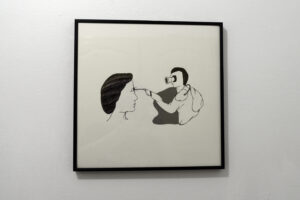
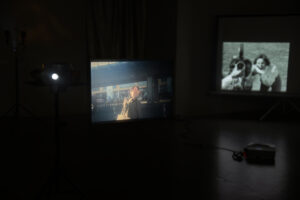
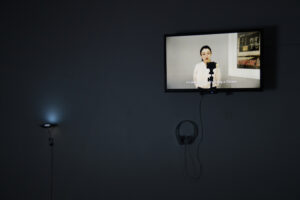
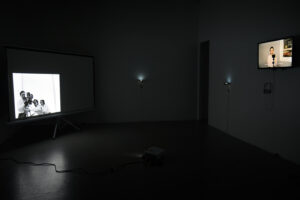
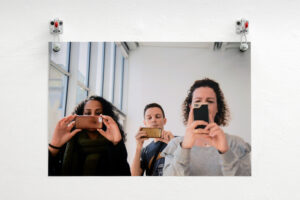
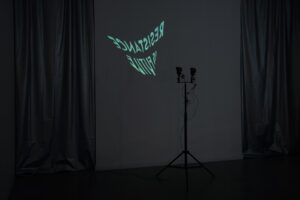
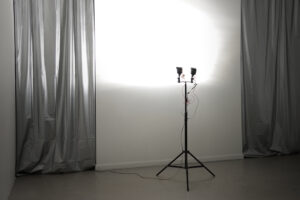
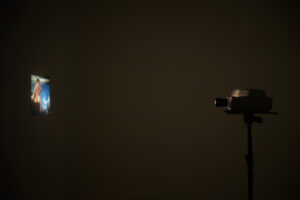
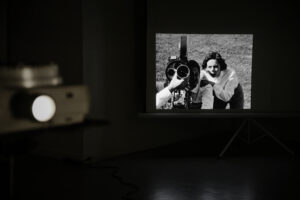
“We are the Borg. Lower your shields and surrender your ships. We will add your biological and technological distinctiveness to our own. Your culture will adapt to service us. Resistance is futile.”
–The Borg, Star Trek, First Contact.
Curatorial Statement
In Resistance is Futile, artist Musquiqui Chihying creates multiple installations that present the various ways in which human beings resist the intrusion of the camera. His media-archaeological practice addresses medium specificity in its representation of image and moving image, and the rediscovery of factual knowledge, history and truth. In Techniques of the Observer: On Vision and Modernity in the 19th Century, art historian Jonathan Crary points out that vision was relocated in the subjectivity of the “observer.” With the development of the optical apparatus, this observer had a sovereign and autonomous visual experience that had never before taken place in the history of vision, while his/her body waited to be regulated by this new experience. Therefore, there is always a tension between human beings and photographic apparatuses, between self-representation and the power of control, between seeing and being seen. The tension becomes the theme of works presented in this exhibition.
In the work The Figure, the artist selected photographic images of his friends in which they consciously or unconsciously covered their faces when they sensed the presence of the camera. Covering their faces in front of the lens, which makes subjects unrecognizable, becomes a straightforward sign of resisting the invasion. The resistance is nonetheless perpetually maintained in the images. In the images, the reason for the covering of faces is unknown, yet these unidentifiable subjects are still visible and present, leaving traces of their existence. Taken by the artist’s phone, the digital images are then reprinted and displayed on film by a now obsolete form of technology–the slide projector. The reversed process–the digital becomes the analog–is a signature gesture in the works of this exhibition, questioning the origin of the images and manipulating the lineage of technology.
The Camera series recreates, in HD video, historical scenes involving struggle over the representation of citizenship and identity in front of the camera. Camera (36) takes the perspective of Korean athlete Sohn Kee-chung in the 1936 Olympic games, when Korea was occupied by the Japanese Empire and he had to represent Japan at the games. In Leni Riefenstahl’s renowned documentary Olympics, Sohn covered his shirt with the Japanese icon Hinomaru (日の丸) by using the oak tree awarded to the champion, a resisting gesture as seen in The Figure. In contrast to Olympics, Camera (36) reverses the direction of the camera Riefenstahl deployed, imagining the working scene of Riefenstahl’s crew when Sohn was awarded the gold medal. Camera (16) re-staged the room where Chou Tzu-yu, the Taiwanese member of popular Korean girl band TWICE, had to apologize for the representation of her own national identity on a variety show. The video of Chou’s apology was widely circulated on social media the night before the 2017 presidential election of Taiwan, intensifying the current political and economic undercurrents between Taiwan, Korea and China. Specifically made for this exhibition, The Camera(17) looked at the controversy in this edition of Whitney Biennial. The Photographer of the widely circulated image in this discussion is invited to re-build the scene where the protest for Dana Schutz’s infamous painting took place.
In The Camera series, reversing the direction of the camera lens signified changes in the power dynamics of seeing, and the hierarchy of images–the high-resolution ones versus the poor images–was twisted. Viewers see the imaginary scenes presented in HD video, while the real images of the incidents, whether the still image from Riefenstahl’s Olympics or the screenshot of Chou’s apology video on the YouTube, are re-made on 35mm reversal films. The performativity of representation and the resistance to the camera in these incidents are not directly seen and can only be imagined through imagery in these different media. But in between a HD video and archive-like films, what will represent and be perceived as reality?
In the work Flash, the complex tension between human beings and cameras is brought into focus. The act of looking is sustained with the existence of light, while blinking light makes the message difficult to be read and interpreted. Until now, we observers, as Crary described, still do not conform to the standard formed by the endless images and moving images that visual machines produced in modern society. What would the camera say to the ready observers if it could talk to humans? When parts of human physicality and sensory experience are regulated by machines, can we escape from a future of the Borg? Or is resistance futile?